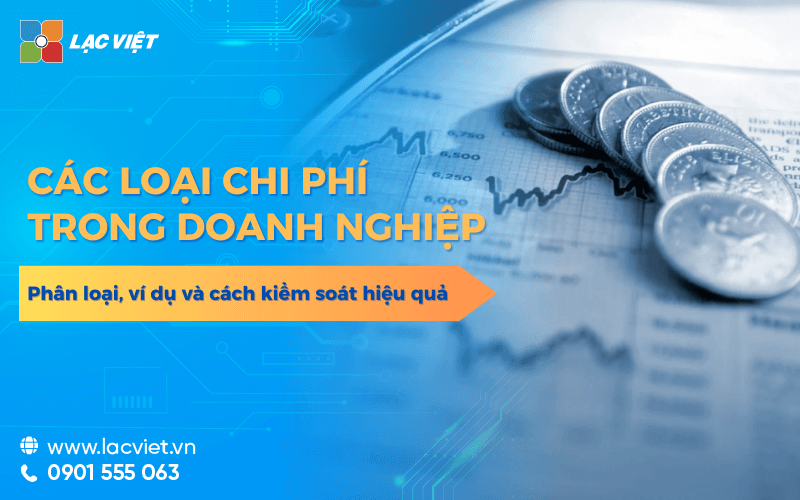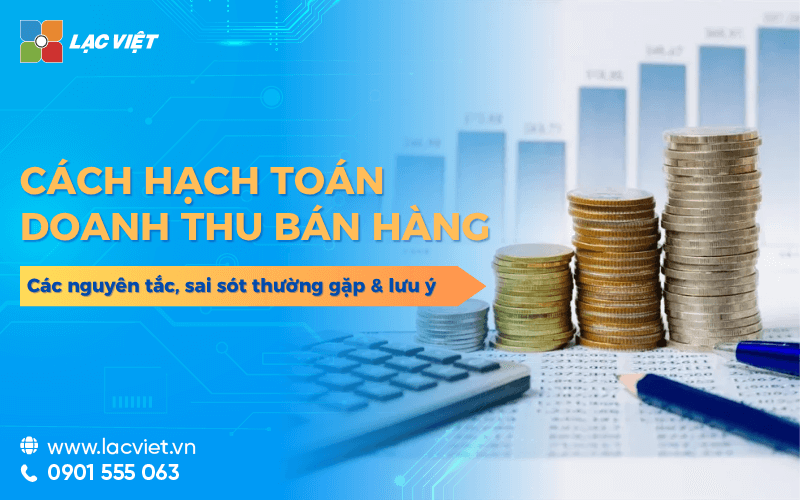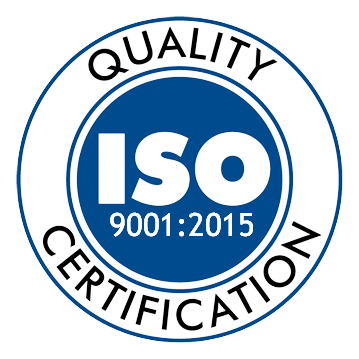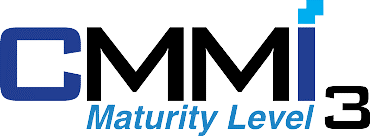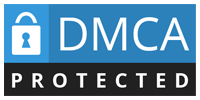In business, increase sales is always the top goal. However, many businesses achieve impressive sales still fall into a state of loss, the reason lies in the operating costs are not tightly controlled. Revenue is the potential market, but the cost of new decisions, profitability, sustainability of the business.
As practice shows, many businesses, especially small and medium only track the total spending that is not classified specific item. Cause they don't know the costs are “flow” to the where clause which are beyond the budget, account, how to bring low efficiency from that difficult decision optimization. Classification of clear, properly manage the types of costs in business is an important foundation for performance measurement, calculate the product price and build strategic long-term finance.
This article Lac Viet Computing will help you clarify:
- The concept of cost in business what is
- Classify the types of expenses common
- Reading comprehension – analysis – evaluation,cost effective,
- Finally, the guide optimal control cost tool suitable solution.
1. Cost in business what is? Why must clear classification?
1.1. The definition of cost in the business
In business activity, the cost is the entire sum of money that businesses have to spend to perform activities that maintain, develop operated apparatus manufacturing business. In other words, the cost is the price paid to create value for the business.
Costs can arise at many different stages, from the purchase of raw materials, pay staff salaries, office rent, operating machinery, until the account depreciation, marketing costs or expenses administrative management. Although the purpose of them are different, but the whole point is: cost directly affects the profitability and financial health of the business.
However, not all types of cost are the same. Each type has different nature, the time recorded various different impact to business results. So, understanding the accurate classification of the type of cost in the business is required to administrators can control the efficient, accurate decisions.
Illustrative examples:
- A account to pay for electricity used for production will be classified in the cost of production.
- But if the same money is power, but used for administrative offices, it is cost management business.
The difference seemed this small if not distinguish right will lead to the financial statements misleading influence, to evaluate the effectiveness of each department to make it difficult to calculate the cost of building the budget or tax settlement.
1.2. Why need to be classified cost?
The classification of clear exactly the kind of costs in the business not only serves the purpose of accounting, but also the platform to enhance effective management and comprehensive treatment. Here are the main reasons:
a) Help control the budget by each department
When expenses are classified by function and department, business easily track the cost of each unit. Support set the budget accordingly, the timely detection where spending in excess or waste. For example, if the cost of marketing rises sharply while revenues did not increase, respectively, the executive board has the facility to review the effectiveness of the campaign.
b) Support the analysis of business performance, determine the breakeven point
Classification of costs as fixed elements – transformation to help businesses determine the breakeven point from which know the minimum quantity should reach to no holes. At the same time, is also the basis for sensitivity analysis of the cost-optimal operating model in a flexible way more effective.
c) Is the basis to build the sale price, tax and financial planning
Sale price products, services, wants to reasonable must be based on the cost structure of. If not clearly define each type of cost, business easygoing wrong price, which leads to the low price cause losses or valuation, but difficult to compete. In addition, the correct classification is also required in the declaration reasonable cost to income tax deduction business.
d) limiting confused avoid risks, legal and accounting
In fact, many businesses still confused between the cost of production with cost of sales or business management. This not only makes financial reporting inaccuracy, but also easily lead to a cost category when the bar – check tax. The correct classification will minimize the legal risks facilitate the audit work, end tax settlement period.
- 10+ accounting software ERP admin most popular AI for enterprises
- [Trọn bộ] File Excel report template production costs with the instructions set details
- Cost management what is a business? Include the account? Controlling the effective circular 200
- Cost analysis business there are any kind? Method, optimal model
2. The cost categories in the most popular businesses today
To finance management efficiency, enterprises not only need to know the total cost, but also to understand the costs incurred of any type, there are properties out why and how does it affect cash flow, rates of profit. Below are the classifications of costs in the business that any manager would also need to know.
2.1 Classification of expenses by function
Cost classification by function is a common approach in management accounting to assess in detail the effect of each activity in the business. The separate clearly the cost of production, cost of sales and cost management to help businesses not only track what's costing more money in the budget, but also determine the correct areas that need adjustments to optimise profits.
a) Cost of production
Are the payments service directly to the process of creating products or services. Includes:
- Raw materials-direct: Wood, fabric, steel, plastic... used in production.
- Direct labour: Wages, allowances of workers directly involved in production.
- Cost of joint production: Electricity, water factory, depreciation of machinery, materials and auxiliary.
Practical example: A company apparel spending 150 million to purchase the fabric, pay 120 million in wage garment workers and 80 million jointly operated factory. The entire 350 million this be classified in the cost of production.
b) Cost of sales
Is the payment service for activities bring products to consumers. Includes:
- The cost of marketing and advertising
- Staff salaries business
- Free, shipping, packing, warehousing finished products
- The cost of promotion, sales commission
Business to determine the level of investment in sales activities have yielded corresponding revenue or not. If you spend a lot, but the order will not increase, the need to re-evaluate marketing strategy or capacity team sale.
c) Cost management business
Is the cost related to operating activities, administration and internal support. Includes:
- Salary board of directors, accounting, administrative
- Office expenses: electricity, water, stationery
- Cost of outsourced services: accounting, legal advice
- The cost, receptions, training, internal
3.2. Classification of costs according to elements forming
This classification helps the business understand each cost incurred from where: from people, materials, property or the Tuesday. This is a useful approach when estimating the budget analysis, the proportion of each element in the total cost.
a) Cost of raw materials
Includes all materials, production service operation, including materials and consumables. For example: Fabric, buttons, ink, oil machinery.
Analysis of the proportion of raw materials helps control waste, negotiate better with suppliers, optimal norms of use.
b) Cost
Includes basic salary, allowances, bonuses, social insurance, and costs related to labor. For example, Wage workers, administrative staff, mandatory insurance.
Better control costs and help the balance between labor productivity and the cost of paying salaries avoid the status of “ballooning” personnel that the performance does not increase proportionately.
c) depreciation of fixed assets
Is the depreciation of assets such as machinery, factories, means of transportation, office equipment... be allocated gradually over the states. For example: printer industry worth $ 500 million depreciation 5 years → per year recorded 100 million.
Visible cost of ownership of equipment over time to support analysis, investment costs and efficient use of assets.
d) the Cost of services purchased in addition
Is the account details for the Tuesday, including outsourced services, transportation, protection, consulting, software... For example: Hire security company, rental management software, personnel, cost of logistics outsourcing.
To help businesses concentrate on core activities, cost savings, long-term compared with the operation of the whole.
e) other cash Expenses
Includes the account not belonging to group on, but still necessary as the cost of conferences, receptions, training, costs related to legal. For example: Organization of workshops, internal invited expert training and management skills.
Maintaining corporate culture, enhance human capacity, enhance brand reputation.
Cost classification by function to help businesses evaluate the effectiveness of each department. Meanwhile, classified according to the element support to control the cost from the root. When combining both methods, the business will have the whole financial picture interface for decision-making, accuracy, transparency more sustainable in cost management.
3.3. Classification of costs in relation to output
The classification of costs according to the relationship with the volume of production help business forecast, planning, budget, determine the break-even point – a survival factor in establishing strategic selling price and scale.
a) fixed Costs
Fixed costs are expenses do not change, though the business produced more or less in a given time period. Type this cost is usually related to the base material, the machine operator.
Specific example: office rent, warehousing; the Salary of the director, personnel administration; depreciation of machinery and the cost of insurance periodically
Fixed costs often is “burden” early on, so business as production much this costs as allocated less on each product → reduce the price of the unit.
b) variable Costs
Variable costs are costs change in proportion with the volume of production – production as much as the higher cost.
Specific example:
- Raw material production
- Workers directly charged according to the product
- Packaging, labels, machining cost outsource calculated according to the number of
Variable costs to help business adjust quickly when there are fluctuations in orders. In the period the revenue has not stable models have variable costs high flexibility than avoid the burden of fixed costs big.
c) mixed Costs
Is the expense had the fixed part has the transformation. This type of cost is common in practice, but often make it difficult to analyze.
Specific example:
- Electricity production: Always have a minimum consumption (fixed) + the change in output.
- Basic salary + salary according to the product of part-time employees
- Outsourced services have a cost to initiate and free as output
Solution: Business should separate mixed costs into fixed part and the variable part of changes based on real data to accurately analyze the breakeven point control prices.
3.4. Classification according to behavioral accounting: direct Costs and indirect
Distinguishing direct costs and indirect costs is a prerequisite to properly calculate the price of products and report accurate financial analysis, business performance according to each item.
a) direct Costs
Direct costs are those expenses can mount directly to a product, service or specific projects without attribution complex.
For example: Raw materials to make each product; the wages paid to workers assemble specific products; packaging is dedicated to a product line
Easy business accurately determine the profit under each item and adjust product strategy – sales price according to the data.
b) indirect Costs
Indirect costs are the account serves for many products, or parts, can not be directly attached to a specific unit.
Specific example: Wage monitoring workshop; The general lighting in the factory; the Cost of lease accounting software, ERP system
Handle direction: Businesses need to set the allocation method is suitable (according to the output, by revenue, over time use...) to record indirect costs into the price of a reasonably transparent.
3.5. The cost reasonable and not reasonable in the tax declaration
From the perspective of tax, only the cost reasonable, valid, will be counted on deductible expenses when determining taxable income. Distinguish right and will help businesses avoid the cost type when settlement and limit the risks of tax arrears.
a) reasonable Cost
Is the cost of satisfying all 3 conditions:
- Serve manufacturing operations – business
- There are bills, vouchers are valid
- Payment via bank if > 20 million/time
For example reasonable: Bills hire security guard services for office; the Cost of living has tables, stats, content apparent; The task has decided to send away, airfare, hotel bills
b) the Cost is not reasonable
Not eligible for vouchers, purpose of use or exceeds the level specified by the tax authorities.
For example, not logical:
- Buy gifts staff, but no invoice
- Chi travel the resort that no decision task
- Overspend mode (for example: cost of advertising exceeds 15% of the revenue with some of the industry apply old)
Consequences: the Cost is the type will increase taxable income → business have to pay additional tax and may be subject to administrative punishment if under inspection.
The clear distinction between the types of costs in terms of output, quality, accounting, rationality valid not only help the enterprise internal management efficiency but also helps meet standards, legal and tax. This is the foundation to medium businesses control the cost of operating medium optimization obligations tax legally sustainable.
4. Controlling the optimal types of costs in the business
Cost is essential to operate a business, but if not tightly controlled, they can become “financial holes” made a profit eroded that leaders don't get out in time. Actual cost management, not cut using a machine that is using the money for the right purpose, the right time the right person. Below are the methods of optimal control of the most cost effective for the organizations and enterprises at every scale.
4.1. Set the system internal control in each group cost
First, enterprises need to build a system of cost control, transparency, hierarchy, with clear responsibility. Not only helps to detect the expenditures unusual but also enhance the active responsibility in each department.
The implementation steps include:
- Classification of costs specific to the department/function: the Cost of production, cost of sales, cost management, business... should be peeled off track independently to control the depth.
- Set limits on spending: Each group costs should be assigned limit clear budget. For example, the marketing department was approved spending $ 100 million/month for advertising, office administration does not exceed 20 million for work for free.
- An approval process spending transparency: Apply approved many levels for the expenditures of great value, combining cross-check between accounting – financial, and used parts.
- Track fluctuations in cost by month/quarter: compare the actual cost with the plan to make timely adjustments if exceeds the threshold.
Business benefits received:
- Control what each expense, avoid loss.
- Increase fiscal discipline, effective use of budget.
- Provide accurate data for the decision to cut or re-investment.
4.2. Application of technology to control costs
The cost control tools, Excel file or paper, it is not only flexible but also easy to errors, time consuming handle difficult given timely warning. The solution is the application of technology to automate the process of collecting, analyzing warning cost.
Some typical tool:
- Accounting software budget (as AccNet ERP): Support plan costs, recorded actual spending, budget comparison in real time.
- Management software, work – processes (such as CoDX): control approval process costs, attachment vouchers, decentralized clear for each management level.
- Solution financial analysis smart – LV Financial AI Agent: This is advanced tools due to Lac development, integrated artificial intelligence to support cost analysis business in a comprehensive manner.
Lac Viet Financial AI Agent to solve the “anxieties” of the business
For the accounting department:
- Reduce workload and handle end report states such as summarizing, tax settlement, budgeting.
- Automatically generate reports, cash flow, debt collection, financial statements, details in short time.
For leaders:
- Provide financial picture comprehensive, real-time, to help a decision quickly.
- Support troubleshooting instant on the financial indicators, providing forecast financial strategy without waiting from the related department.
- Warning of financial risks, suggesting solutions to optimize resources.
Financial AI Agent of Lac Viet is not only a tool of financial analysis that is also a smart assistant, help businesses understand management “health” finance in a comprehensive manner. With the possibility of automation, in-depth analysis, update real-time, this is the ideal solution to the Vietnam business process optimization, financial management, strengthen competitive advantage in the market.
SIGN UP CONSULTATION AND DEMO
LV Financial AI Agent brings what value?
- Automatically collected classify costs according to each department, item, period.
- Warning costs exceeding the threshold as soon as they arise, help administrators proactively handle.
- Trend analysis cost by month/quarter/year and give suggestions cuts based on real data.
- Compare the results using cost between the states, help with decisions, and allocate resources more intelligently.
Try it now analysis tools smart financial at:
https://lacviet.vn/lac-viet-financial-ai-agent
Expense management has never just stop at the “spend less” which is more important is to understand the correct – classification of clear – tight control effective use. The identification of the exact types of costs in the business, from the cost of production, sales, management to fixed cost, variable, direct, indirect... not only keeps accounting records get the right data, but also help management see clearly its strong and weak points in the operation from which the correct decision in a timely manner.

